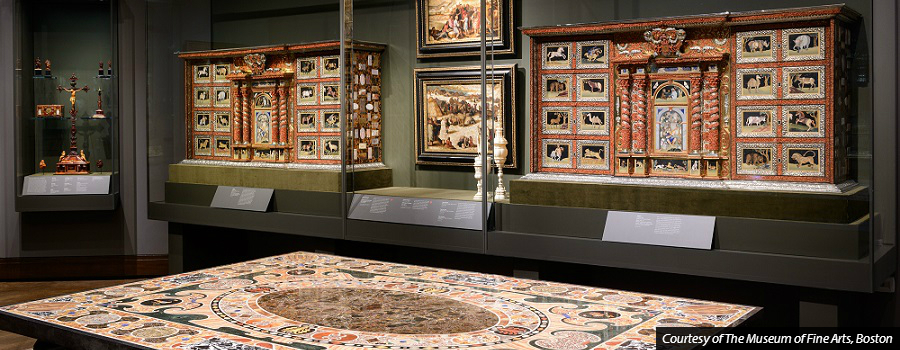The Kunstkammer Gallery at the Museum of Fine Arts, Boston

The newly installed Kunstkammer Gallery at the Museum of Fine Arts, Boston, which opened on June 4, 2014 as part of the museum’s larger project to renovate the display of European art in the Evans Wing, aims to replicate for the modern viewer the dazzling experience of entering just such a space in the Renaissance and Baroque era. The museum’s re-creation of a sixteenth- to seventeenth-century encyclopedic kunstkammer—literally, “art room” or cabinet of curiosities, conceived as the universe in microcosm—showcases a diverse array of naturalia, artificialia, and exotica. These objects splendidly attest to the period’s fascination with works wrought by nature or man (or, more often than not, an elision of the two) and exotic materials hailing from far-flung shores.
The exhibition’s one hundred twenty-three sumptuous works, many shown to the public for the first time after recent conservation efforts, appeal to the eye and invoke pure aesthetic admiration. The panoply of objects boasts diversity befitting a kunstkammer, in media (paintings, books, automata, metal sculptures, ostrich eggs, nautilus shells, rock crystal, ivory, and amber, just to name a few) and scale (ranging from a diminutive hand-held portrait medallion from England to a monumental Roman inlaid marble table that dominates the space upon entry), with each object given its due as a singular rarified treasure in the gallery display. As such, the curatorial aim to exemplify the kunstkammer’s breadth and depth is a great success, all the more impressive given that many of the objects are culled from the museum’s permanent collection (the notable counterpoint to the MFA’s exhibition in the United States is the Chamber of Art and Wonders at the Walters Art Museum in Baltimore).
The gallery’s introductory wall text advances the argument for the exhibit to follow, primarily casting the kunstkammer space and the objects therein as princely status symbols and exemplars of artistic virtuosity, and inviting viewers to share in the wonder of beholding such exquisite works. Thus the exhibition’s insistent curatorial focus and overall organizing principle are firmly predicated upon the craftsmanship of the objects displayed, as evidenced by special displays such as “Arts of Fire” and “Art and Nature.” Interjecting contextual display headings, when they appear (such as “The Renaissance in France” and “The Artist as Virtuoso in the Italian Renaissance”), punctuate lengthier technical descriptions of amber and pietre dure (inlaid hard stone), but seem randomly interspersed.
On balance, however, the MFA’s effort to provide such contextualized displays of works is highly commendable, and the Kunstkammer Gallery is a welcome addition that offers visitors a unique opportunity to envision a Renaissance/Baroque-era collection, at least hypothetically, as a totality. Yet the unintended outcome of the exhibition’s emphasis on quality and materiality leaves the viewer with the historically inaccurate impression of the kunstkammer as a disjointed space, composed without logic or consideration for cohesion, and inadvertently gives short shrift to the enterprise of collecting as a distinctly personal act, subject to the idiosyncrasies of an individual within the confines of an intimate space.